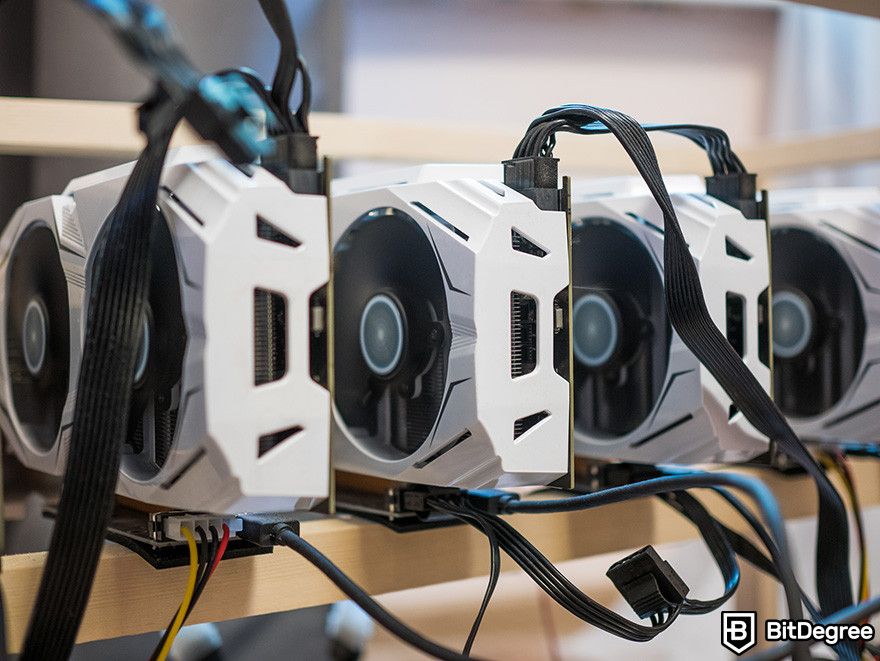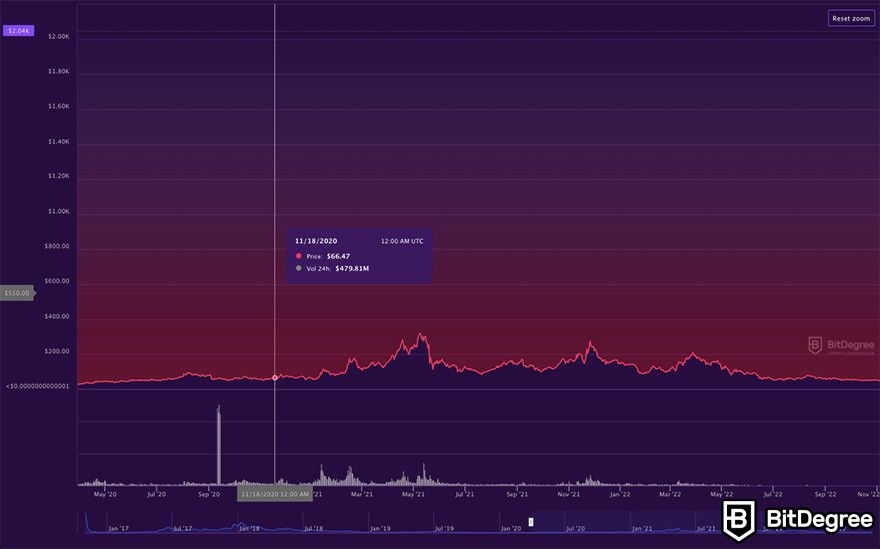Zcash Halving Countdown
Time remaining until Zcash block rewards will be cut in half:
🎁 Free Airdrop Season 7 is LIVE! Answer fun questions or do simple tasks to earn rewards from the $30K BitDegree prize pool. Participate Now !
Zcash
ZEC| Halving | Est. Halving Date | Block | Block Reward |
|---|---|---|---|
| #1 | November 18, 2020 | 1,046,400 | 3.125 ZEC |
| #2 | Sometime in 2024 | 2,092,800 | 1.5625 ZEC |
| #3 | Sometime in 2028 | 3,139,200 | 0.78125 ZEC |
| #4 | Sometime in 2032 | 4,185,600 | 0.390625 ZEC |
Market Cap
$527,492,049
Circulating Supply
15,886,821 ZEC
Max Supply
21,000,000 ZEC
Hash Rate
7.6Bh/s
Mining Difficulty
57.94M
Current Block
2,888,354
Current Block Reward
6.25 ZEC
Block Reward After Halving
3.125 ZEC
Zcash halving is a phenomenon that interests and excites a lot of crypto enthusiasts around the globe. If you’re looking for specific ZEC halving dates or even some general information about the phenomenon in question, you’ll find all your questions answered in this text!
When is the Next Zcash Halving?
The next Zcash halving is estimated to take place sometime in 2024. For a more precise estimate, check out our countdown tool above.
When Will the Last Zcash Halving Happen?
The last Zcash halving will happen right before the maximum total supply of 21 million Zcash is reached (minted and available on the market). The exact date for this is still unknown, but it should be in the very distant future.
What is the Zcash Halving History?
To date, Zcash has only had a single halving event, back on November 18, 2020. On that day, the mining rewards for the crypto asset in question were reduced to 3.125 ZEC per block mined.
What is Zcash Halving?
Zcash halving is a process when mining rewards for this network’s underlying cryptocurrency (ZEC) are reduced in half every set period of time (4 years or so).
While ZEC halving is very similar to that of some other popular cryptocurrencies, like Bitcoin, it still comes equipped with a few specific intricacies that are worth looking into and understanding. First, however, you need some background information on Zcash as a standalone crypto project.
Zcash: Bitcoin, Proof-of-Work, and More
Zcash was created in 2016 as a fork of Bitcoin. The purpose of this particular cryptocurrency, straight from the get-go, was to become the “Bitcoin of privacy coins”. In other words, Zcash focuses exclusively on providing token holders with the utmost privacy and anonymity features.
Like Bitcoin, Zcash also uses the Proof-of-Work consensus algorithm to secure its network and mint new coins on the blockchain. However, this is a given - if there was no PoW, there wouldn’t be any traditional halvings involved either.
If you’re not yet aware of what Proof-of-Work and Zcash halvings have in common, you should know that PoW utilizes miners for all of the required network securing and block production operations. Zcash isn’t ASIC-resistant, either. This means that miners are able to use powerful ASIC mining machines in order to boost their Zcash mining proficiency.
Granted that the entire purpose of Zcash halvings is to reduce the inflation of the asset by halving mining rewards, you can probably already tell that miners are going to be the group that’s impacted the most by this phenomenon. More on that later, though - first, we need to look into the specifics of ZEC halvings.
How Does Zcash Halving Work?
Zcash halvings are very similar to those of Bitcoin. This is probably pretty obvious, granted that the cryptocurrency in question was a fork of BTC.
The core difference, however, lies in numbers. Take a look at the table below:
| Date | Block Height | Block Rewards |
|---|---|---|
| November 18, 2020 | 1,046,400 (?) | 3.125 ZEC |
| Est. 2024 | 2,092,800 (?) | 1.5625 ZEC |
| Est. 2028 | 3,139,200 (?) | 0.78125 ZEC |
| Est. 2032 | 4,185,600 (?) | 0.390625 ZEC |
| ... | ... | ... |
| ? | ? | ? |
Table: Zcash halving schedule
Admittedly, a lot of information provided in the table might come off as a bit confusing - allow me to clear things up.
When Zcash was first created, it offered a block mining reward of 12.5 ZEC. In 2019, the network underwent an update known as the Blossom Upgrade. One of the things that happened during that update was the halving of block rewards. From the day it was created up until November 18, 2020, the reward for mining a Zcash block was 6.25 ZEC.
In a way, this was a very unconventional halving. Being part of a larger upgrade, however, it’s not seen as one - the “traditional” first halving is considered to have happened on the earlier-mentioned date (the first in the table above).
So, reward-wise, everything is pretty straightforward - every 4 years or so, the rewards for mining a block get halved. However, what’s with all of the perceived ambiguity regarding the block height and specific Zcash halving dates?
Well, as I’ve just told you, the ZEC halving happens approximately every 4 years. The exact dates are difficult to define, granted that the halving is hard-coded into the blockchain and depends not on a set date but on block height.
This is where things get a bit tricky. Specifically, to some people, it’s unclear how many blocks need to be mined for the halving to take place. Some sources cite 840,000 blocks, while others - 1,046,400 blocks (since this was the initial block that triggered the first Zcash halving).
What’s the actual number? Well… I’m sorry to say that it’s pretty unclear!

Even on Zcash’s official website, you’d struggle to find any mention of specific block heights, as far as they relate to the halving dates. The team behind the project points out the halving intervals as being “about every four years” - that much we’ve figured out already.
Adding some simple maths to the equation doesn’t necessarily help the case, either. A single block takes 75 seconds to mine - since a year has 31,536,000 seconds, this would result in 420,480 blocks mined per year, or 1,681,920 blocks per the 4-year period. Again, the numbers don’t really add up.
That being the case, depending on the current block height and taking the table-mentioned numbers as the standard, it’s still possible to calculate the approximate time frames of the next Zcash halving date.
How do Zcash Halvings Affect the Price of ZEC?
One big aspect that would be impossible to ignore when talking about Zcash halving dates is the price of ZEC - or rather, how it fluctuates and changes around the time when a halving event happens.
Since there has only been a single ZEC halving as of yet, the date is, admittedly, quite limited. Still, though, let’s take a look at the chart below:

The line represents the day when the first Zcash halving happened. Interestingly enough, as you can probably see for yourself, nothing major happened with the asset’s price tag - there were no sudden spikes or downfalls.
Is this out of the ordinary? Well, not really, no. The only cryptocurrency whose halving effects can be seen almost immediately is Bitcoin. Smaller projects usually don’t “make a lot of waves” within the market, price fluctuation-wise.
On top of that, it’s worth keeping in mind that this was, once again, the very first official ZEC halving. It wouldn’t really be possible to say what the future halving events will bring for this particular cryptocurrency when it comes to changes in price.
The Significance of Zcash Halvings
The final point that we need to discuss when it comes to Zcash halvings is their significance to the crypto community - specifically, miners, investors, and everyone in between.
When the first ZEC halving happened, the annual inflation rate of the ZEC coin dropped to 12.5%. As time goes on and more halving events follow, this number is bound to drop even lower - it’s something that has been coded into the network structure itself, so it’s pretty much a given.
This is great news for investors in the project. If you hold ZEC and believe in what the project is all about (in this case - privacy and anonymity), you probably assume that the native token will rise in price as well. Halvings are a predetermined method of boosting this very concept - they create scarcity, and if the demand remains the same or increases, the price will follow in most cases.

If you’re a miner, though, your feelings regarding the Zcash halvings might be a bit less straightforward. An increase in the asset’s price would, in fact, mitigate the halving of mining rewards. However, in the case of Zcash (as well as quite a few other halving-employing cryptos), it’s observable that this wasn’t the case - the halving simply did not affect the price, at least in an immediate manner.
If you’re looking to purchase some ZEC coins or perhaps even want to start mining the crypto yourself, understanding Zcash halvings is a crucial part of the process! While the event may not have affected the price of the asset, it was only the first halving of multiple ones to come - keep an eye on that countdown above!
Summary
Let’s have a quick summary of what we’ve discussed in this article, shall we?
The key takeaways are:
- Zcash halving is an event when ZEC block mining rewards are halved;
- It happens approximately every 4 years;
- There has currently only been a single ZEC halving, which occurred in November 2020;
- Since Zcash is a fork of Bitcoin, the halvings of these two cryptos are somewhat similar;
- The first Zcash halving didn’t affect the price of the asset, at least not in any notable manner.
Keeping all of these points in mind, it’s exciting to see what the next Zcash halving brings us!
Conclusions
Now that you’re knowledgeable in regards to all things Zcash halvings, make sure to keep an eye on the ZEC halving date countdown above. Whether you’re an investor, a miner, or a crypto enthusiast in general, knowing the specific date of the next halving can prove to be very beneficial!
Other Halving Dates

